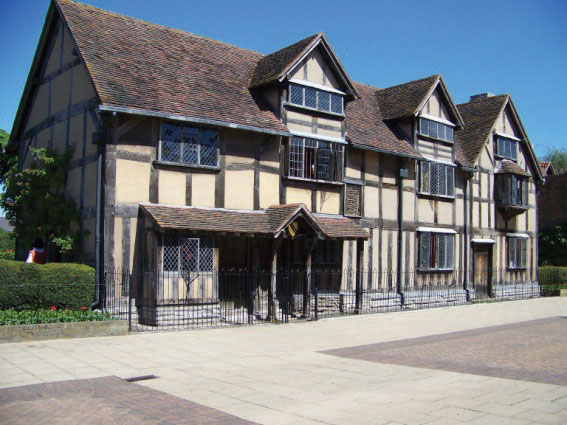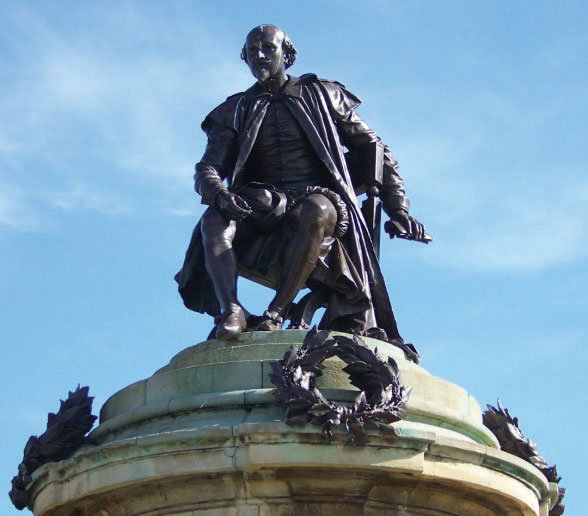This is “William Shakespeare (1564–1616)—The Sonnets”, section 3.3 from the book British Literature Through History (v. 0.1). For details on it (including licensing), click here.
For more information on the source of this book, or why it is available for free, please see the project's home page. You can browse or download additional books there. To download a .zip file containing this book to use offline, simply click here.
3.3 William Shakespeare (1564–1616)—The Sonnets
PLEASE NOTE: This book is currently in draft form; material is not final.
Learning Objectives
- Identify the English sonnet structure of Shakespeare’s sonnets.
- Recognize vestiges of the Italian sonnet structure in the content of some Shakespearian sonnets.
- Analyze the use of 5 key themes in Shakespeare’s sonnets: time, poetry, beauty, love, and friendship.
Biography

William Shakespeare (1564–1616) is undoubtedly the most well-known and revered name in British literature.
Although entire books of speculation about Shakespeare’s personal life and history abound, little documentary evidence exists. The Folger Shakespeare Library, the British Library, and BBC Historic Figures provide basic biographical information.
His birth, his marriage, the births of his children, and his death are recorded in the parish records of Holy Trinity Church in Stratford-upon-Avon. Also, a few records of business transactions and a few government documents provide enough information for scholars to know that he lived in several places in London, bought a large house in Stratford-upon-Avon, and was involved in some legal proceedings. Shakespeare’s will survives in the National Archives.

Shakespeare’s birthplace in Stratford-upon-Avon.

Shakespeare’s grave in Holy Trinity Church, Stratford-upon-Avon.
Text
- Facsimile of The Sonnets Quarto One. The Library of the University of California, Los Angeles. Internet Shakespeare Editions. University of Toronto.
- Sonnets. Open Source Shakespeare:An Experiment in Literary Technology. George Mason University.
- Shakespeare’s Sonnets by William Shakespeare. Project Gutenberg.
- Sonnets. Electronic Text Center. University of Virginia Library.
The Sonnets
Although Shakespearian sonnets are named for Shakespeare, he was not the first, or the only, person to write sonnets in this form. And not all of his sonnets are entirely English in form. Shakespeare also used elements of the Italian form.
Shakespeare’s sonnets do not constitute a typical sonnet sequence because they do not all address a single topic. By the time Shakespeare was writing his sonnets, the sonnet sequence, usually tracing a love story, had declined in popularity. However, there are five themes that appear throughout all his sonnets: time, poetry, beauty, love, and friendship.

Statue of Shakespeare at the Shakespeare Memorial Theatre, Stratford-upon Avon.
Some scholars, such Barbara A. Mowat and Paul Werstine, editors of the New Folger Library Shakespeare edition of Shakespeare’s Sonnets, view Shakespeare’s sonnets as autobiographical, referring to “the story that the sequence as a whole seems to tell about Shakespeare’s love life.”
Other critics find that interpretations of Shakespeare’s sonnets often reveal as much or more about the age in which the critiques are written than about the sonnets themselves. Michael Schoenfeldt, for example, writing in The Cambridge Companion to Shakespeare’s Poetry (Ed. Patrick Cheney. Cambridge University Press, 2007. Cambridge Collections Online.) asserts that “… the Sonnets have frequently functioned as a mirror in which cultures reveal their own critical presuppositions about the nature of poetic creation and the comparative instabilities of gender, race, and class. Although the Sonnets have proven particularly amenable to some of the central developments of late twentieth-century modes of criticism—particularly feminism and gender and gay studies—they continue to be richer and more complex than anything that can be said about them.”
Although some scholars read Shakespeare’s sonnets as autobiographical, others remind us that in literature the narrative voice should not be assumed to be the author but is instead a persona created by the author. Scholar Helen Vendler, for example, uses the term “fictive speaker” in reference to the speaker of the sonnets (The Art of Shakespeare’s Sonnets. Harvard University Press, 1997).
Key Takeaways
- Shakespeare’s sonnets consistently develop 5 themes: time, poetry, beauty, love, and friendship.
- Shakespeare’s sonnets are English in structure although some sonnets retain elements of the Italian structure.
- Many theories of literary criticism posit that Shakespeare’s sonnets, like most literature, should not be read autobiographically.
Exercises
- In Shakespeare’s Sonnet 29, identify elements that belong to the Petrarchan or Italian tradition. Also locate elements that would characterize the sonnet as an English sonnet.
- In Sonnets 55 and 73, identify the topic of each of the three quatrains. What images are developed in each quatrain? How are these images related? How do the couplets function in these two sonnets?
- In Sonnet 130, how does the speaker address the Petrarchan convention? How does the couplet affect the reader’s perception of the rest of the sonnet?
Resources
Biography
- “Excerpts from Shakespeare’s Will.” Treasures. The National Archives.
- “Shakespeare.” Holy Trinity Church, Stratford-upon-Avon.
- “The Shakespeare Paper Trail: The Early Years.” British History In-depth. BBC.
- “The Shakespeare Paper Trail: The Later Years.” British History In-depth. BBC.
- “Shakespeare’s Biography.” Shakespeare Resource Center.
- “Shakespeare’s Life.” Folger Shakespeare Library.
- “Shakespeare’s Life.” Treasures in Full: Shakespeare in Quarto. British Library.
- William Shakespeare. Dr. Carol Lowe. McLennan Community College.
- “William Shakespeare.” Historic Figures. BBC.
Text
- Facsimile of The Sonnets Quarto One 1609 at the Library of the University of California, Los Angeles. Internet Shakespeare Editions. University of Toronto.
- Open Source Shakespeare: An Experiment in Literary Technology. George Mason University.
- Shakespeare’s Sonnets by William Shakespeare. Project Gutenberg.
- Sonnets. Shakespeare, William, 1564–1616. Electronic Text Center. University of Virginia Library.
Audio
- Shakespeare’s Sonnets. Read by Sir John Gielgud. HarperAudio. Internet Multicasting Service.
- Sonnets. By William Shakespeare. LibriVox.
- Sonnet Central Listening Room.
Video
- “William Shakespeare.” Dr. Carol Lowe. McLennan Community College.
Images
- “William Shakespeare.” Great Britons: Treasures from the National Portrait Gallery, London.




